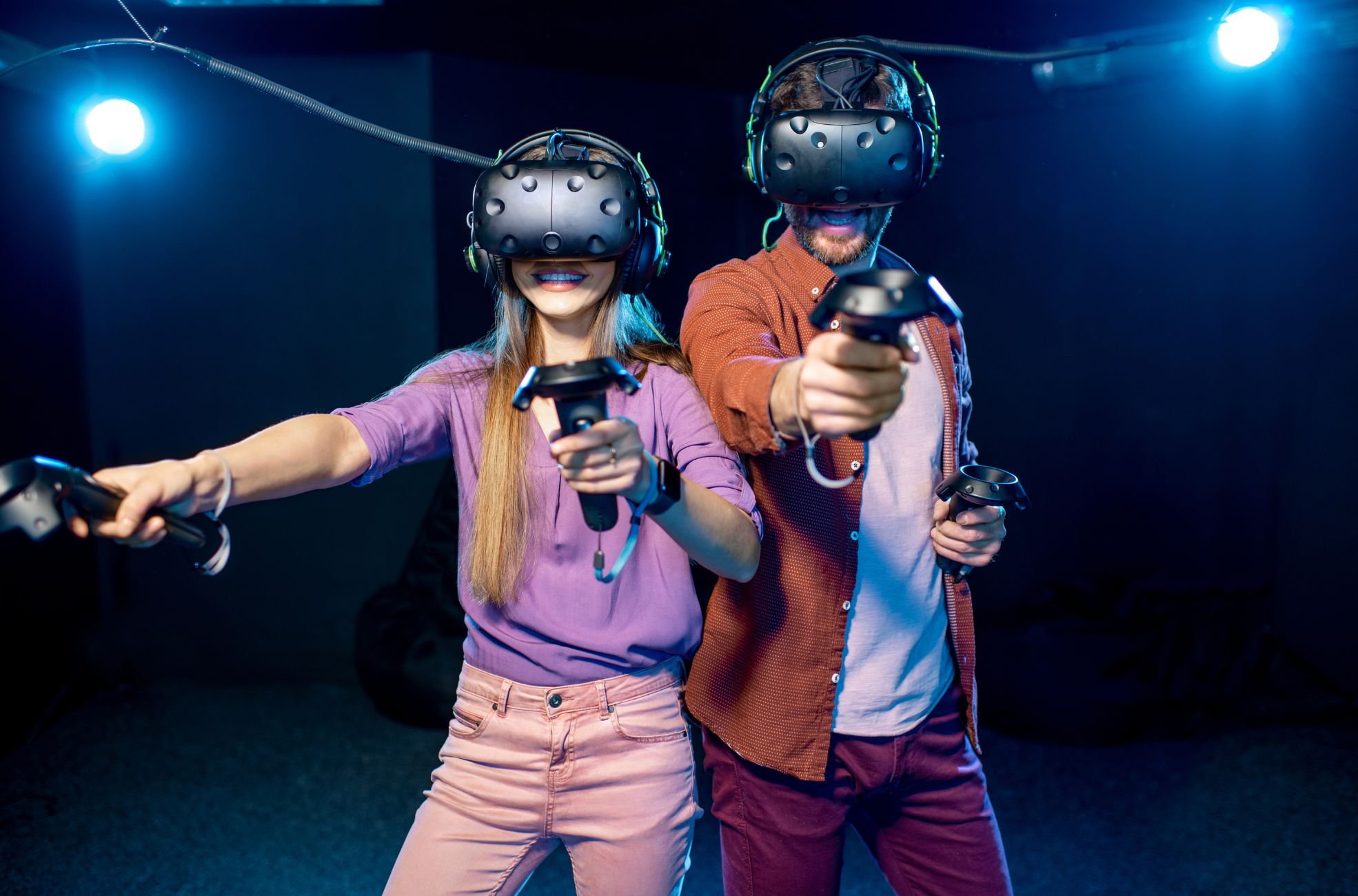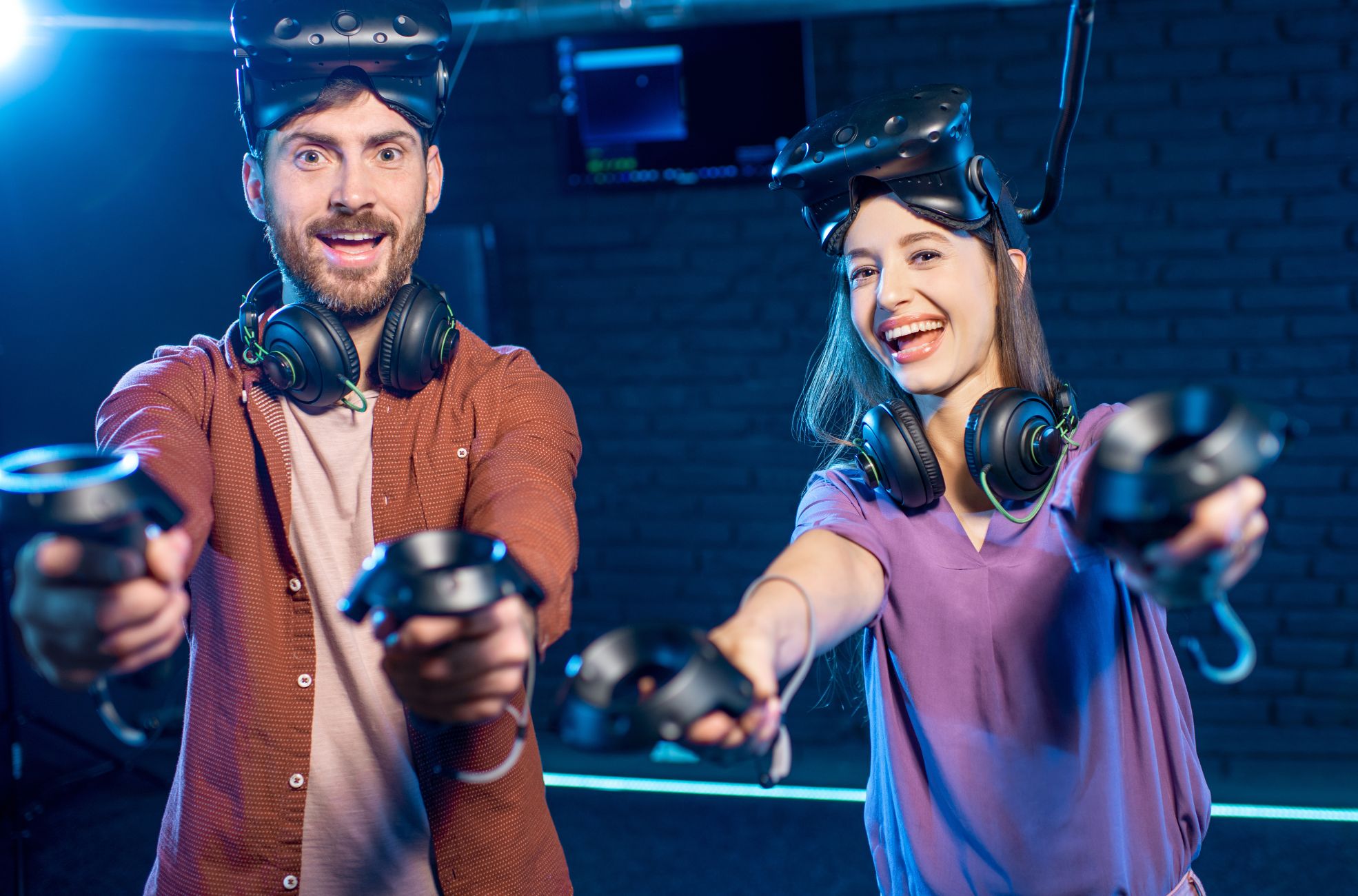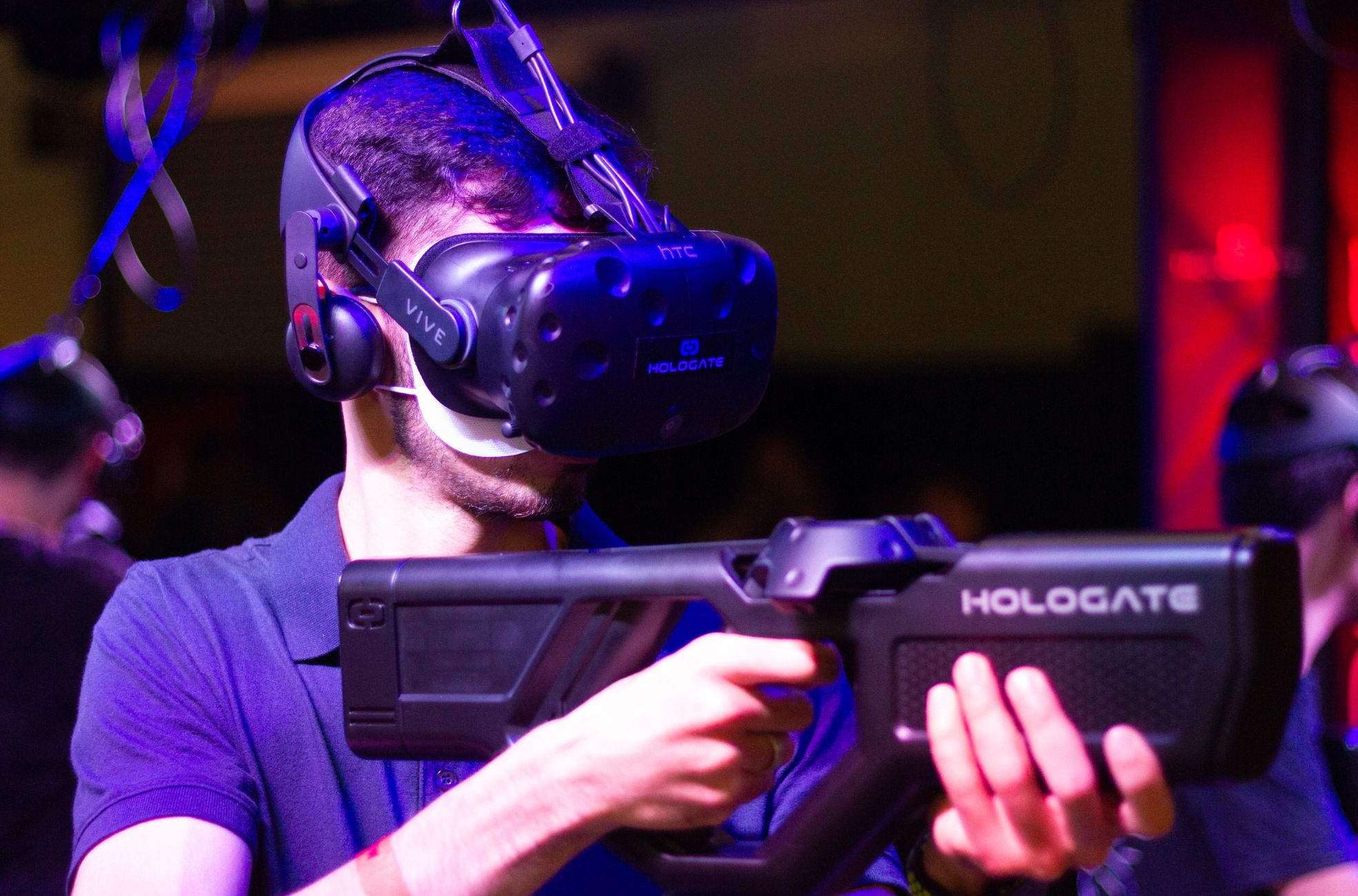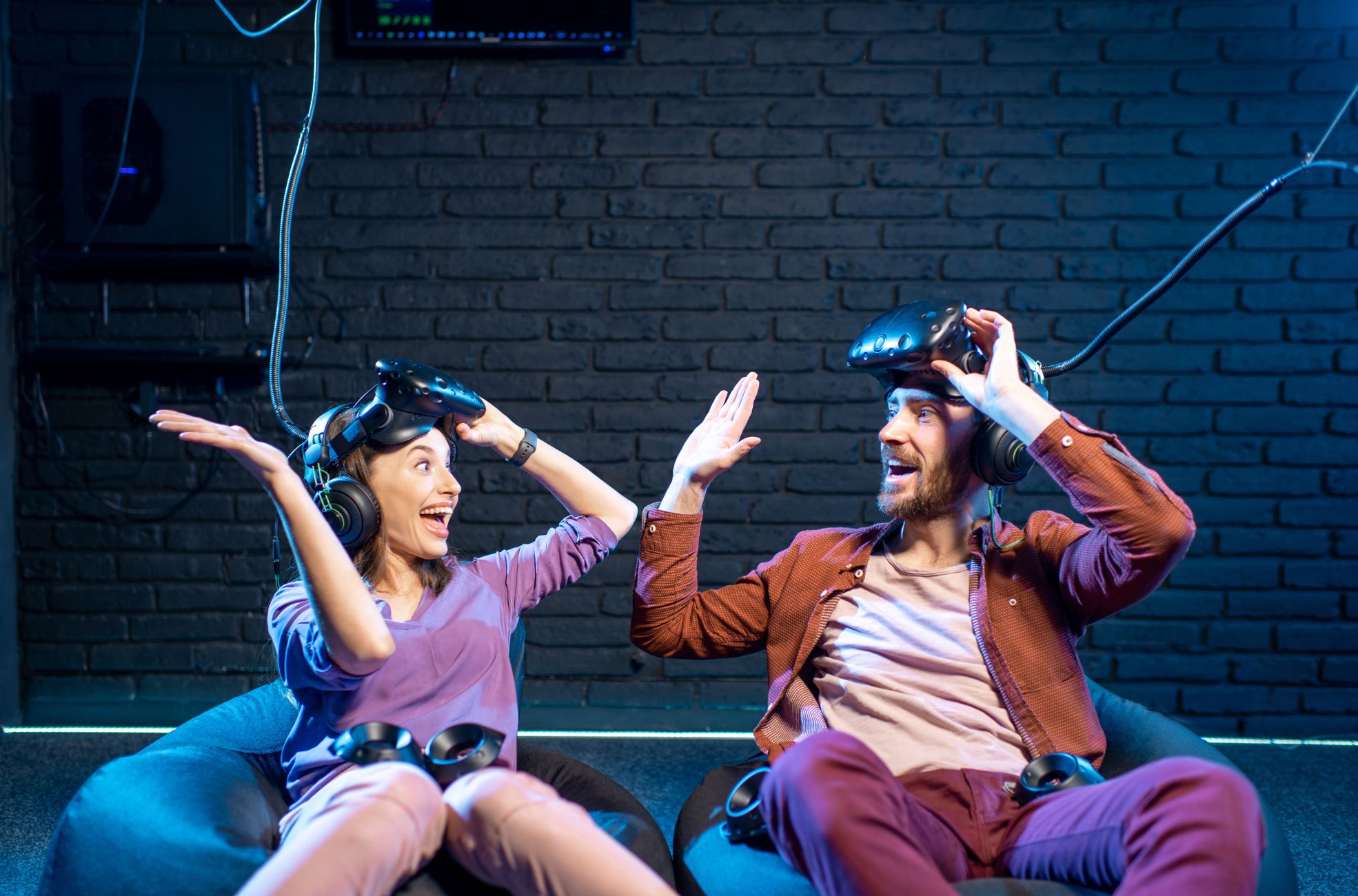Immersive entertainment has revolutionised the event industry, offering guests a chance to enter a world where every sense is engaged, and every experience is memorable. As we explore the realms of Virtual Reality (VR), Augmented Reality (AR), and beyond, event planners are now equipped to create truly transformative experiences. Whether for corporate gatherings, cultural exhibitions, or private festivities, integrating immersive elements ensures your event stands out.
We focus on strategic objectives planning, understanding audience demographics, and selecting the perfect venue. We will guide you through the process of crafting an event that’s not only spectacular but also resonates on a personal level with each attendee. Join us as we explore the art of creating events that captivate the imagination and leave a lasting impact.
Planning Your Immersive Event
Setting Objectives and Goals
Starting your event planning without clear objectives is like setting sail without a compass. It’s important to establish goals for your event; they’re the specific outcomes you’re aiming for, and using the 5-W framework—Who, What, When, Where, and Why—gives you a structured approach to understanding every aspect of your event.
It’s important to align your event goals with the needs and wants of your audience, as they’re the foundation of your business. Whether your attendees are loyal customers, newcomers, or key stakeholders, you should cater to each group with specific objectives in mind.
Goals should be SMART—Specific, Measurable, Achievable, Relevant, and Time-bound—to ensure they’re realistic and trackable. For example, you might aim to boost brand awareness by a certain percentage or generate more revenue than the previous year. Thought leadership could also be a goal, positioning your event as a source of valuable industry knowledge.
Objectives, meanwhile, are the measurable steps you take to reach these goals, such as acquiring a set number of leads within a specific timeframe. By setting and tracking milestones, like social media engagement or email marketing metrics, you can gauge the success of your event and make informed decisions.
Audience Demographics and Preferences
Knowing who your audience is and what they want is key to creating an event that resonates with them. Demographic analysis offers insights into the audience’s age, geographic location, socioeconomic status, gender identity, and industry, which in turn informs their lifestyle, purchasing decisions, and cultural influences. For instance, the age range can suggest life stages that affect their interests, while geographic location can highlight cultural nuances.
Audience analysis goes beyond demographics; it involves adapting your event to the audience’s interests, understanding, attitudes, and beliefs. Knowing the audience’s knowledge and attitudes towards a topic helps you tailor the content to their expectations. Keep in mind that the size of the audience and whether their attendance is voluntary will also affect their engagement with your event.
Most audience members are egocentric, meaning they’re primarily interested in content that directly impacts them or their community.
Choosing the Right Venue
The venue is the canvas for your immersive event. It shapes the event’s atmosphere and the attendees’ experience from the moment they walk in. The venue’s location, layout, and local flavour all contribute to the overall impression of your event.
Whether you’re planning a corporate event that requires a professional ambience and technological facilities or a private event looking for ambience, catering, and entertainment, selecting the venue requires careful thought.
A thorough venue checklist should cover space setup, minimum spending, and access to preferred suppliers. It’s not just about the physical space; it’s about the experience you’re crafting. From the convenience of the location to the flexibility of the layout and the range of essential services offered, every detail counts.
Conducting site visits, building relationships with venue staff, and understanding contract details are all part of the detailed planning process. Whether it’s an outdoor space with natural surroundings or an urban setting with modern amenities, the right venue sets the stage for a memorable event.
Integrating Theme and Storytelling
The essence of an immersive event is its ability to transport attendees into a narrative that captivates and engages them. Integrating a theme and storytelling into your event isn’t just about aesthetics; it’s about creating a cohesive experience that aligns with your objectives and strikes a chord with your audience. The theme should be woven through every aspect of the event, from the venue selection to the activities and entertainment on offer.
Storytelling is a powerful tool that can convey the message of your event, connect with attendees on an emotional level, and leave a lasting impression. It’s about crafting a narrative relevant to your audience, aligning with your brand, and enhancing the overall experience. Whether through interactive elements, multimedia presentations, or live performances, storytelling can turn a standard event into an immersive adventure.

Types of Immersive Entertainment Options
Virtual Reality (VR) Experiences
VR is transforming the way we engage with content at events. Participants can be transported into a simulated world, offering a level of interaction beyond traditional setups’ capabilities.
This technology is adaptable for various applications, from entertainment to educational purposes, such as simplifying complex subjects. In a corporate context, VR can present products in a fully interactive 3D space, allowing for a more profound connection with the offerings.
Additionally, VR facilitates virtual attendance, broadening the reach of an event and enhancing networking possibilities without the constraints of physical presence.
Augmented Reality (AR) Activities
AR merges digital enhancements with the real environment, offering a unique layer of interaction through everyday devices like smartphones. This technology can enrich the attendee experience by providing interactive 3D models and detailed information in an engaging format.
Web AR, accessible without additional software, is increasingly becoming a staple at events due to its broad compatibility. The continued advancement of AR, VR, and XR is set to innovate attendee interactions further.
Interactive Performances
These performances involve attendees in the action, transforming them from observers to participants. Engaging in activities such as interactive games or creative workshops can stimulate both mental and physical activity.
Such content increases engagement and promotes collaboration and networking, leaving a lasting impact on participants.
Environmental and Sensory Enhancements
An event can become more immersive by stimulating all senses. Visuals such as dynamic lighting and projection mapping, auditory elements like tailored soundtracks or performances, and tactile experiences with interactive installations contribute to a multi-sensory environment.
Additionally, carefully selected scents and gastronomic offerings can create positive associations with the brand, enhancing the overall experience.
Roving Entertainers and Interactive Characters
These performers can enliven an event by mingling with attendees, offering unique and tailored interactions. They can facilitate networking and engagement by serving as conversational catalysts.
Immersive Theatre and Live Action Role-Playing (LARP)
Immersive theatre and LARP invite attendees to step into a story and actively shape the narrative. These experiences encourage creative involvement and can be particularly effective in creating an engaging and memorable event.

Best Practices for Creating Immersive Experiences
Designing Interactive and Engaging Content
To captivate your audience, creating content that resonates with them is essential. Use insights from past events, social media, and market research to understand your attendees comprehensively. Engage with them through surveys and interactive posts to refine your offerings and demonstrate that their opinions are valued. A consistent theme across all communications will help maintain a cohesive narrative.
Incorporating a variety of content formats, such as multimedia presentations and interactive elements like quizzes, can maintain interest. Facilitate community building by encouraging dialogue and participating in activities promoting hands-on learning and structured networking.
Utilising Technology to Enhance Immersion
Embracing technology can significantly amplify the immersive quality of your event. VR can simulate environments for skill practice without risk. AR and MR can create a seamless blend of digital and physical experiences. At the same time, 360-degree media provides a panoramic view of settings.
Choosing virtual event platforms with interactive capabilities, such as virtual networking spaces and breakout rooms, can foster real-time engagement. Introducing gamification can motivate attendees through competition. Providing on-demand content ensures inclusivity for participants in various time zones.
Incorporating Multi-Sensory Elements
Engaging multiple senses is a must for a comprehensive, immersive environment. Beyond visual and auditory elements, immersive theatre and performances can create a space that fully involves attendees, often erasing the boundary between performer and spectator. By doing so, events can evoke emotions and forge memorable experiences.
Training Staff to Facilitate Immersive Experiences
Event staff are integral to the success of immersive experiences. They need to be proficient in technology management and adept at engaging with attendees. Prompt feedback and tailored interactions are essential. Staff should also be skilled in fostering participant connections and eliciting input.
Utilising analytics tools to monitor engagement and reach can help staff make informed adjustments to optimise content interaction and ensure the event’s enduring success.
Augmented and Virtual Realities: Crafting Immersive Experiences
In the realm of event entertainment, AR and VR offer attendees experiences that go beyond traditional interaction. While AR enhances the real world by overlaying digital content, VR whisks users away to entirely virtual environments.
Understanding what you need and prefer is the secret to crafting a successful immersive experience. It’s about knowing your objectives, the context of the experience, and any challenges you might face. Choosing the right platform is crucial in the development of AR/VR experiences.
Creating engaging content is just as important as it is the foundation of an immersive experience. However, these technologies come with their own set of challenges, including the significant development costs and the need for skilled developers.
Despite these obstacles, the potential applications of AR/VR are vast, covering industries from gaming and education to healthcare, all of which aim to provide engaging and interactive user experiences.
The Power of Interactive Content
Interactive content is a lively alternative to static content. It engages the audience actively rather than just speaking to them. This type of content, which includes polls, surveys, and questionnaires, not only grabs and keeps the viewer’s attention but also acts as an efficient, cost-effective promotional tool.
Interactive content can provide valuable insights into audience preferences by encouraging audience participation. This enables you to create a follow-up list for future marketing efforts. Applications like Cultural Places offer digital tools that boost engagement at heritage or cultural sites.
The main goal of such content is to keep the audience engaged throughout the event. It encourages active participation and can increase attendance. Moreover, interactive presentations foster a dialogue with the audience, enhancing learning and team building and allowing for personalised content delivery.
Artificial Intelligence: Enhancing Personalisation and Responsiveness
AI can greatly boost the processing power and responsiveness of immersive technologies, leading to experiences that are not only more personalised but also more emotionally engaging. AI’s ability to analyse vast amounts of data, recognise patterns, and predict user behaviour enhances the interactivity of games and other applications.
AI provides real-time adjustments and personalised challenges. AI-driven visuals and character design, supported by Natural Language Processing (NLP), can create environments and avatars that respond realistically to in-game events, thus lifting the user experience.
Furthermore, AI and spatial audio help create a 3D sound environment, adding realism and depth to the virtual world. As AI continues to evolve, it’s important to consider transparency, accountability, and the ethical implications of privacy and data protection when creating XR content.
Multi-sensory Events: Engaging All Senses for Impactful Engagement
Stimulating all human senses can greatly enhance an event’s effectiveness, leading to increased creativity and engagement. Multi-sensory events aim to take guests on a journey by engaging sight, touch, hearing, smell, and taste.
High-quality visuals, tactile interactions, clear and balanced sound, evocative scents, and exceptional catering all contribute to a memorable event experience. However, it’s essential to avoid sensory overload. The various elements should complement rather than compete with each other.
Multi-sensory events can inspire action, creativity, and discussion by stimulating the senses creatively and engagingly. They stand out and become memorable, capturing attention, sparking excitement, and even going viral, thereby enhancing the event’s overall impact.
Training Event Staff: Ensuring Success Through Expertise
The success of an event often hinges on the proficiency of its staff. In experiential marketing, where real-life connections and sensory experiences are key, well-trained event staff are vital. They draw in consumers and create positive, memorable experiences.
Various methods to effectively train event staff include online resources, video conferencing, and in-person sessions. Training materials should be engaging and cover essential topics such as brand overview, event goals, brand messaging, technical elements, and security procedures.
Incorporating staff training into the initial budget and making sure staff are tested on key points are critical steps in preparing them for the event. By investing in thorough training, event organisers can set the stage for a successful event that resonates with attendees and achieves the desired return on investment.

Create Your Immersive Event Experience
Crafting an immersive event is an art that reflects a deep understanding of your audience and your brand’s unique narrative. It’s about creating a world within your event that enthrals the senses, sparks the imagination, and forges meaningful connections.
By harnessing the power of VR, AR, and interactive content and by engaging with attendees through every touchpoint, you set the stage for success. Your meticulous choice of venue, thoughtful integration of technology, and the magic of storytelling all converge to transform an ordinary gathering into an unforgettable journey.
Remember, it’s the delicate balance of spectacle and substance that will not only meet but exceed your participants’ expectations. When every element is finely tuned, your event becomes the ultimate experience that resonates long after the final curtain call.







